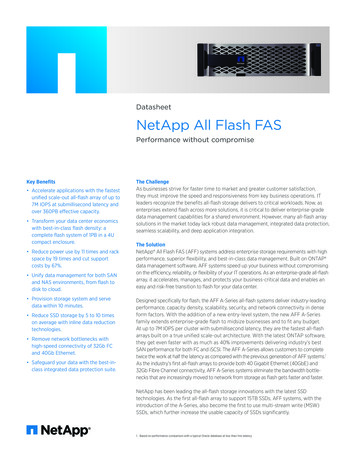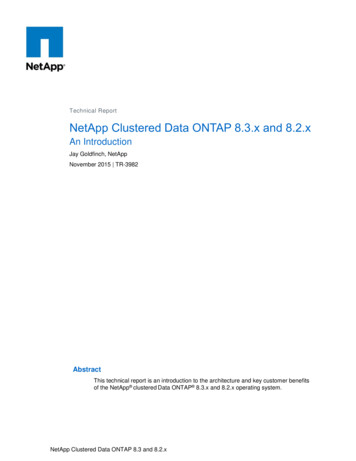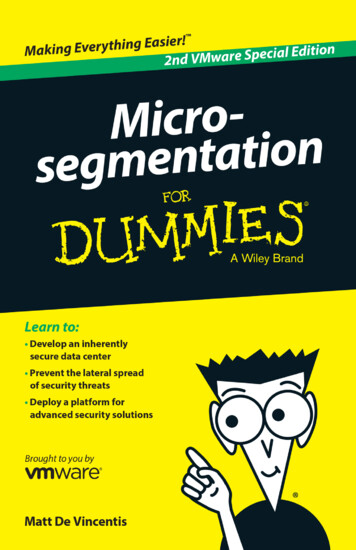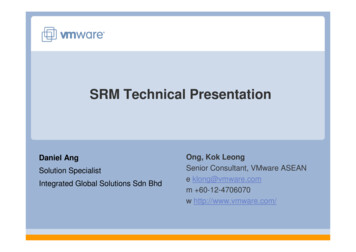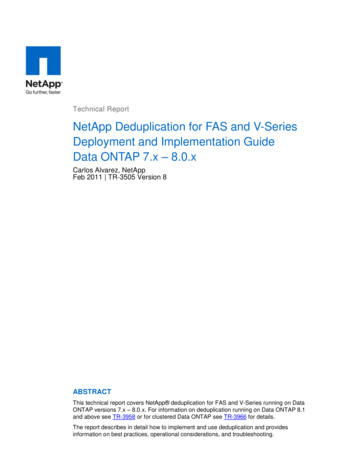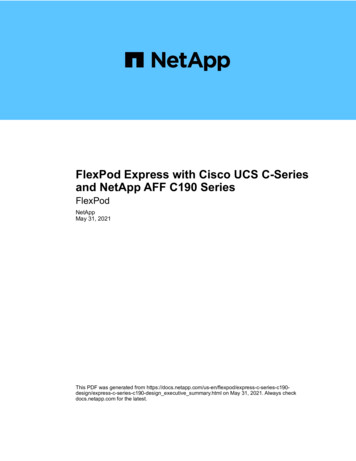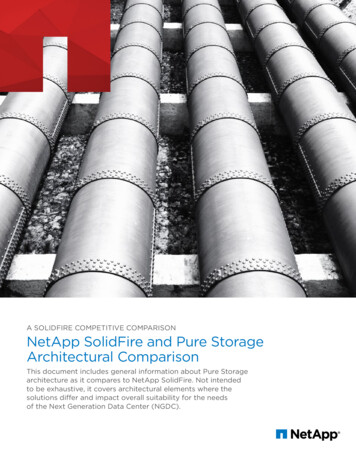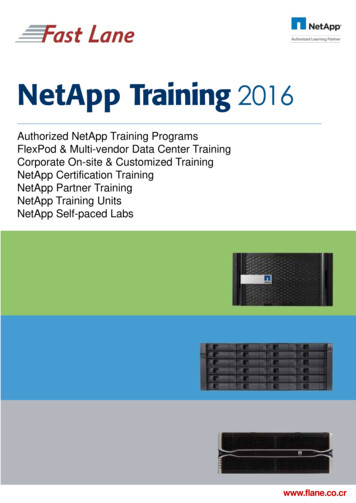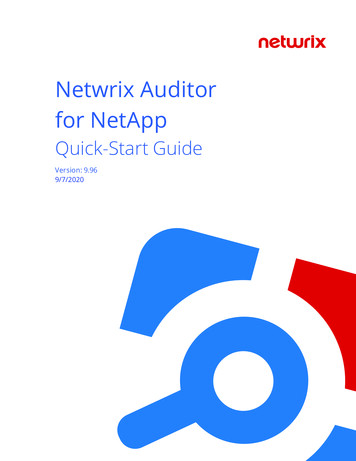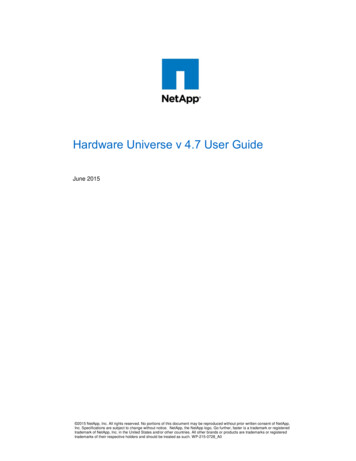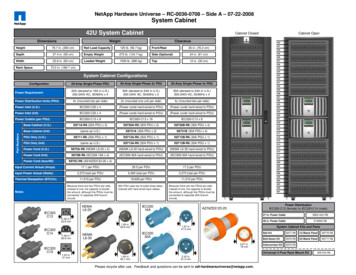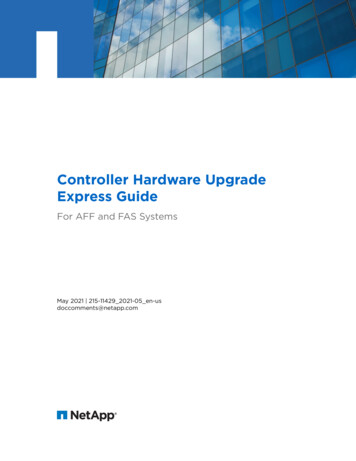
Transcription
Technical ReportNetApp and VMware View Solution GuideBest Practices for Design, Architecture, Deployment, andManagementChris Gebhardt and Abhinav Joshi NetAppFebruary 2010 TR-3705 Version 4.0ABSTRACTThis document provides NetApp best practices on designing, architecting, deploying, and managing ascalable VMware View 4 (VDI) environment on NetApp storage.
TABLE OF CONTENTS1EXECUTIVE SUMMARY. 42SCOPE . 53INTRODUCTION TO VMWARE VIEW . 64VMWARE VIEW DEPLOYMENT MODELS . 74.156789VMWARE VIEW MANAGER DESKTOP DELIVERY MODELS . 7NETAPP SOLUTION AND COMPONENTS. 105.1STORAGE EFFICIENCY . 105.2PERFORMANCE . 125.3OPERATIONAL AGILITY . 135.4DATA PROTECTION. 16NETAPP AND VMWARE VIEW MANAGER DESKTOP DELIVERY MODELS. 186.1INDIVIDUAL DESKTOP . 196.2MANUAL DESKTOP POOL . 206.3AUTOMATED DESKTOP POOL . 20ACCELERATING VMWARE VIEW WITH READ AND WRITE I/O OPTIMIZATION . 237.1CONCEPTS . 237.2BENEFITS OF INTELLIGENT CACHING . 237.3DEDUPLICATION AND NONDUPLICATION TECHNOLOGIES . 247.4THE PERFORMANCE ACCELERATION MODULE . 257.5TRADITIONAL AND INTELLIGENT CACHING. 257.6SUMMARY OF INTELLIGENT CACHING IN A VMWARE VIEW ENVIRONMENT . 30STORAGE SIZING BEST PRACTICES . 328.1GATHER ESSENTIAL SOLUTION REQUIREMENTS . 328.2PERFORMANCE-BASED AND CAPACITY-BASED STORAGE ESTIMATION PROCESS . 34STORAGE ARCHITECTURE BEST PRACTICES . 449.1STORAGE SYSTEM CONFIGURATION BEST PRACTICES . 4410 INSTALLING AND CONFIGURING THE RAPID CLONING UTILITY . 4710.1INSTALLING THE RAPID CLONING UTILITY . 4710.2CONFIGURING THE RAPID CLONING UTILITY . 5111 DEPLOYING NETAPP SPACE-EFFICIENT VM CLONES . 5511.1OVERVIEW OF DEPLOYING NETAPP SPACE-EFFICIENT CLONES . 5511.2DETAILS OF DEPLOYING NETAPP SPACE-EFFICIENT CLONES. 5612 USING RCU REDEPLOY. 7113 VMWARE VIEW OPERATIONAL BEST PRACTICES . 7513.12DATA DEDUPLICATION . 75NetApp and VMware View Solution Guide for Architecture, Deployment and Management – Version 4.0
13.2ANTIVIRUS OPERATIONS . 7913.3MONITORING NETAPP AND VMWARE VIEW INFRASTRUCTURE . 8013.4DATA PROTECTION SOLUTION . 8014 SUMMARY . 8115 ACKNOWLEDGEMENTS . 8216 FEEDBACK . 8217 REFERENCES . 8218 VERSION HISTORY . 833NetApp and VMware View Solution Guide for Architecture, Deployment and Management – Version 4.0
1EXECUTIVE SUMMARYThe NetApp solution enables companies to optimize their virtual infrastructures by providing advancedstorage and data management capabilities. NetApp provides industry-leading storage solutions that simplifyvirtual machine (VM) provisioning; enable mass VM cloning and redeployment; handle typical I/O bursts, forexample, boot storm, antivirus storms, efficient OS, application, and user data management, and so on;provide individual VM backup and restores; deliver simple and flexible business continuance; and helpreduce virtual desktop storage.This solution guide provides guidelines and best practices for architecting, deploying, and managingVMware View (VDI) solutions on NetApp storage systems. NetApp has been providing advanced storagefeatures to VMware ESX-based solutions since the product began shipping in 2001. During that time,NetApp has continuously enhanced the design, deployment, and operational guidelines for the storagesystems and ESX Server–based VDI solutions. These techniques have been documented and are referredto as best practices. This solution best practices guide describes them in detail.Note: The best practices are only recommendations, not requirements. Following these best practices willnot determine whether your implementation is supported by NetApp and VMware. Not all recommendationsapply to every scenario. NetApp believes that its customers will benefit from thinking through theserecommendations before making any implementation decisions. In addition to this document, professionalservices are available through NetApp, VMware, and our joint partners. These services can be an attractivemeans to assure optimal virtual storage architecture for your virtual infrastructure.The target audience for this paper is familiar with concepts pertaining to VMware vSphere, includingVMware ESX 4, VMware vCenter Server 4, and NetApp Data ONTAP 7.3.1P2 or greater. For high-levelinformation and an overview of the unique benefits that are available when creating a virtual infrastructureon NetApp storage, see Comprehensive Virtual Desktop Deployment with VMware and NetApp.4NetApp and VMware View Solution Guide for Architecture, Deployment and Management – Version 4.0
2SCOPEThe scope of this document is to provide architectural, deployment, and management guidelines forcustomers that are planning or have already decided to implement VMware View on NetApp virtualizedstorage. It provides a brief overview of the VMware View technology concepts; key solution architectureconsiderations for implementing VMware View on NetApp; storage estimation and data layoutrecommendations; and solution, deployment, and management guidelines.5NetApp and VMware View Solution Guide for Architecture, Deployment and Management – Version 4.0
3INTRODUCTION TO VMWARE VIEWCorporate IT departments are facing a new class of desktop management issues as they strive to provideend users with the flexibility of accessing corporate IT resources using any device from any network. IT isalso being asked to provide access to corporate resources for an increasingly dispersed and growingaudience that includes workers in off-site facilities, contractors, partners, and outsourcing providers as wellas employees traveling or working from home. All of these groups demand access to sensitive corporateresources, but IT must make sure of strict adherence to corporate security requirements and new regulatorystandards.VDI enables organizations to increase corporate IT control, manageability, and flexibility of desktopresources while providing end users with a familiar desktop experience. VMware View is an enterprise-classsolution to deliver corporate PC services to end users. VMware View 4 solution components might includebut are not limited to: Virtualization hypervisor (VMware ESX 4.0) Tool for centralized management, automation, provisioning, and optimization (VMware vCenter, NetAppRapid Cloning Utility, VMware View Composer) Connection brokering and desktop management (VMware View Manager) Virtualized desktop images (Windows XP, Vista, Windows 7, and so on) Enhanced Windows profile and data management solutions (for example, RTO Software andAppSense) Thin client/PC (for example, Wyse, DevonIT)VMware View 4, based on the proven VMware vSphere virtualization platform, delivers unique desktopcontrol and manageability, while providing end users with a familiar desktop experience without anymodifications to the desktop environment or applications.6NetApp and VMware View Solution Guide for Architecture, Deployment and Management – Version 4.0
4VMWARE VIEW DEPLOYMENT MODELSFor any customer environment, the types of desktop can be classified as either persistent or nonpersistent.PERSISTENT DESKTOPSPersistent desktop can be defined as desktops that are permanently assigned to a single user, arecustomizable, and no other user is entitled to use this desktop. The user logs into the same desktop everyday, and the changes made to the system image (new data, applications, registry changes) are savedacross login sessions and reboots. This is exactly like a traditional laptop or desktop with all thecustomizations and personal data stored locally on the C drive. This model might however include the use ofCIFS home directories and/or profile redirection for better user data and profile management. This is acommon type of VDI deployment model that is used today for knowledge workers, mobile workers, andpower users and is a major driver for increased shared storage requirement.NONPERSISTENT DESKTOPSNonpersistent desktops can be defined as desktops that are not assigned to a specific user. The user couldget assigned to a different virtual desktop at every login. This deployment model could be used for taskworkers (for example, call centers workers, tellers, students, or medical professionals) and some knowledgeworkers who require little control of their desktops.One might choose to implement either of these models or a mix based on the business requirements, typesof users, and proportion of users represented by different job functions.4.1VMWARE VIEW MANAGER DESKTOP DELIVERY MODELSVMware View Manager is the VMware virtual desktop management solution that improves control andmanageability and provides a familiar desktop experience.Figure 1) VMware View features (source: VMware).7NetApp and VMware View Solution Guide for Architecture, Deployment and Management – Version 4.0
At a high level, there are multiple types of desktop delivery models available in VMware View Manager: Individual desktops: This can be classified as a preassigned desktop that has been precreated,populated in VMware vCenter Server, imported into VMware View Manager, and assigned to one ormore users. The users log in to the same desktop every time, and the user settings and data on the OSdisk are preserved across login sessions and reboots. However, it allows only one active user on thedesktop at a time. Individual desktops are considered as “nonpersistent” because even though a userlogs into same desktop every time, other users are also entitled to use that desktop (although not at thesame time). Manual desktop pools: This is a pool of desktops and provides mapping of multiple users to multipledesktops, with only one active user on a desktop at a time. These types of desktops have to bemanually precreated with using VMware full clones or tools with space-efficient VM provisioningcapabilities, for example, NetApp RCU, and automatically imported into VMware View Manager.The manual desktop pool supports two types of access modes:- Persistent: Users are assigned a desktop that can retain all of their documents, applications,and settings between sessions. The desktop is statically assigned the first time the user connectsand is then used for all subsequent sessions.- Nonpersistent: Users are not assigned to particular desktops and could get connected to adifferent desktop from the pool each time they connect. Also, there is no persistence ofenvironmental or user data between sessions. Automated desktop pools: This is also a pool of desktops and provides mapping of multiple users tomultiple desktops, with only one active user on a desktop at a time. The creation and customization ofthese types of desktops are driven by VMware View Manager and optionally with VMware ViewComposer by using either of these two options:- Full clone: Leveraging VMware vCenter Server virtual machine template to create VMware fullclones.- Linked clone: Leveraging VMware View Composer feature in VMware vCenter Server to createVMware linked clones.Both these options in automated desktop pools support the two types of access modes:- Persistent: Users are assigned a desktop that can retain all of their documents, applications,and settings between sessions. The desktop is statically assigned the first time the user connectsand is then used for all subsequent sessions.- Nonpersistent: Users are not assigned to particular desktops and could get connected to adifferent desktop from the pool each time they connect. Also, there is no persistence ofenvironmental or user data between sessions. Terminal server pool: This is a pool of terminal server desktop sources served by one or moreterminal servers. Discussion on the storage best practices for this type of desktop delivery model isoutside the scope of this document.Table 1) Desktop delivery models.8Desktop Delivery Models for VirtualDesktopsVirtual Desktop Provisioning MethodVirtual DesktopPersistence ModeIndividual DesktopVMs precreated and available in VMwarevCenter ServerNonpersistentManual Desktop PoolVMs precreated and available in VMwarevCenter ServerPersistentNonpersistentNetApp and VMware View Solution Guide for Architecture, Deployment and Management – Version 4.0
Desktop Delivery Models for VirtualDesktopsVirtual Desktop Provisioning MethodVirtual DesktopPersistence ModePersistentInvoke VMware full clone to create VMsNonpersistentAutomated Desktop PoolPersistentInvoke VMware linked clone to create VMsNonpersistentFor more details on VMware View desktop delivery models and access modes, refer to the VMware ViewManager Administrator Guide.9NetApp and VMware View Solution Guide for Architecture, Deployment and Management – Version 4.0
5NETAPP SOLUTION AND COMPONENTSNetApp provides a scalable, unified storage and data management solution for VMware View. The uniquebenefits of the NetApp solution are: Storage efficiency: Significant cost savings with multiple levels of storage efficiency for all the VM datacomponents. Performance: Enhanced user experience with intelligent read and write I/O optimization that stronglycomplements NetApp’s storage efficiency capabilities. Operational agility: Enhanced VMware View solution management with tight partner integration. Data protection: Enhanced protection of both the virtual desktop OS data and the user data, with verylow overhead for both cost and operations.SINGLE SCALABLE UNIFIED ARCHITECTUREThe NetApp unified storage architecture provides customers with an agile and scalable storage platform.NetApp’s innovative solutions provide customers new alternatives and expanded possibilities over traditionalstorage vendors. All NetApp storage systems utilize the Data ONTAP operating system to provide SAN(FCoE, FC, iSCSI), NAS (CIFS, NFS), primary storage, and secondary storage within a single platform sothat all virtual desktop data components can be hosted on the same storage array. A single process foractivities such as installation, provisioning, mirroring, backup, and upgrading is used throughout the entireproduct line from the entry level to enterprise-class controllers. Having a single set of software andprocesses brings great simplicity to even the most complex enterprise data management challenges.Unifying storage and data management software and processes reduces the complexity of data ownership,enables companies to adapt to changing business conditions without interruption, and results in a dramaticreduction in total cost of ownership.For large, scalable VMware View environments, the NetApp solution provides the following unique benefits: At least 50% savings in storage, power, and cooling requirements Most agile and operationally efficient storage solutions Best-in-class data protection and business continuance solutions to address any level of dataavailability demands5.1STORAGE EFFICIENCYOne of the critical barriers to VDI adoption in general is increased cost, specifically associated withincreased shared storage requirement. Virtual desktop deployment creates a high level of data redundancy,especially for the VM OS data. Using traditional storage, this means you need storage equal to the sum ofthe storage required by each VM. For example, if each VM is 20GB in size and there are supposed to be1,000 VMs in the solution, it would require at least 20TB usable data on the shared storage.Thin provisioning, data deduplication, and FlexClone are the critical components of the NetApp solutionand offer multiple levels of storage efficiency across the virtual desktop OS data, installed applications, andthe user data. This helps customers save on average 50% to 90% on the cost associated with sharedstorage (based on existing customer deployments and NetApp solutions lab validation). NetApp is the onlystorage vendor that offers data deduplication for live virtual machines, without any negative tradeoffs.10NetApp and VMware View Solution Guide for Architecture, Deployment and Management – Version 4.0
THIN PROVISIONINGThin provisioning is a way of logically presenting more storage to hosts than physically available. With thinprovisioning, the storage administrator is able to utilize a pool of physical disks (known as aggregate) andcreate logical volumes for different applications to use, while not preallocating space to those volumes. Thespace gets allocated only when the host needs it. The unused aggregate space is available for the existingthinly provisioned volumes to expand or for
Terminal server pool: This is a pool of terminal server desktop sources served by one or more terminal servers. Discussion on the storage best practices for this type of desktop delivery model is outside the scope of this document. Table 1) Desktop delivery models. Desktop Delivery Models for Virtual Desk
